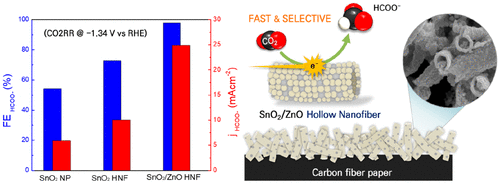当前位置:
X-MOL 学术
›
ACS Sustain. Chem. Eng.
›
论文详情
Our official English website, www.x-mol.net, welcomes your
feedback! (Note: you will need to create a separate account there.)
SnO2/ZnO Composite Hollow Nanofiber Electrocatalyst for Efficient CO2 Reduction to Formate
ACS Sustainable Chemistry & Engineering ( IF 7.1 ) Pub Date : 2020-06-28 , DOI: 10.1021/acssuschemeng.0c03481 Daniel Tan 1, 2 , Wonhee Lee 1 , Young Eun Kim 1 , You Na Ko 1 , Min Hye Youn 1 , Ye Eun Jeon 1 , Jumi Hong 1 , Soon Kwan Jeong 1, 2 , Ki Tae Park 1
ACS Sustainable Chemistry & Engineering ( IF 7.1 ) Pub Date : 2020-06-28 , DOI: 10.1021/acssuschemeng.0c03481 Daniel Tan 1, 2 , Wonhee Lee 1 , Young Eun Kim 1 , You Na Ko 1 , Min Hye Youn 1 , Ye Eun Jeon 1 , Jumi Hong 1 , Soon Kwan Jeong 1, 2 , Ki Tae Park 1
Affiliation

|
Electrocatalytic reduction of CO2 to formate has become one way to increase the value of CO2 and to overcome the climate change issue. Novel catalysts for the critical role of enhancing reaction selectivity have been continuously explored to provide the best performance. Lately, composite materials have drawn much attention because the synergistic effect between the components provides enhanced physical and chemical properties. Here, we present a highly efficient CO2 reduction reaction to formate on a tin(IV) oxide/zinc oxide (SnO2/ZnO) composite electrocatalyst with a grainy hollow nanofiber (HNF) structure. The faradaic efficiency (FE) of formate on the SnO2/ZnO composite HNF reaches as high as 97.9% at −1.34 V vs reversible hydrogen electrode (RHE), outperforming many tin-based catalysts. At −1.54 V (vs RHE), the SnO2/ZnO HNF exhibits 2 times and 4 times higher current density for formate generation than those of SnO2 HNF and nanoparticles (NPs), respectively. This superior catalytic performance is attributed to its one-dimensional continuous structure as well as to the synergistic effects between SnO2 and ZnO, which facilitate faster electron transfer and improve the conductivity of SnO2/ZnO composite HNF.
中文翻译:

SnO 2 / ZnO复合空心纳米纤维电催化剂可有效还原CO 2生成甲酸酯
电催化将CO 2还原为甲酸酯已成为增加CO 2值并克服气候变化问题的一种方法。为了增强性能,人们一直在不断探索新型的催化剂,这些催化剂在提高反应选择性方面起着至关重要的作用。最近,复合材料备受关注,因为组件之间的协同作用增强了物理和化学性能。在这里,我们提出了一种高效的CO 2还原反应,以在具有粒状中空纳米纤维(HNF)结构的氧化锡(IV)/氧化锌(SnO 2 / ZnO)复合电催化剂上形成甲酸酯。SnO 2上甲酸的法拉第效率(FE)与可逆氢电极(RHE)相比,/ ZnO复合材料HNF在-1.34 V时高达97.9%,胜过许多锡基催化剂。在-1.54 V(vs RHE)下,SnO 2 / ZnO HNF的甲酸生成电流密度分别比SnO 2 HNF和纳米颗粒(NPs)高2倍和4倍。这种优异的催化性能归因于其一维连续结构以及SnO 2和ZnO之间的协同作用,促进了更快的电子转移并提高了SnO 2 / ZnO复合HNF的电导率。
更新日期:2020-07-27
中文翻译:

SnO 2 / ZnO复合空心纳米纤维电催化剂可有效还原CO 2生成甲酸酯
电催化将CO 2还原为甲酸酯已成为增加CO 2值并克服气候变化问题的一种方法。为了增强性能,人们一直在不断探索新型的催化剂,这些催化剂在提高反应选择性方面起着至关重要的作用。最近,复合材料备受关注,因为组件之间的协同作用增强了物理和化学性能。在这里,我们提出了一种高效的CO 2还原反应,以在具有粒状中空纳米纤维(HNF)结构的氧化锡(IV)/氧化锌(SnO 2 / ZnO)复合电催化剂上形成甲酸酯。SnO 2上甲酸的法拉第效率(FE)与可逆氢电极(RHE)相比,/ ZnO复合材料HNF在-1.34 V时高达97.9%,胜过许多锡基催化剂。在-1.54 V(vs RHE)下,SnO 2 / ZnO HNF的甲酸生成电流密度分别比SnO 2 HNF和纳米颗粒(NPs)高2倍和4倍。这种优异的催化性能归因于其一维连续结构以及SnO 2和ZnO之间的协同作用,促进了更快的电子转移并提高了SnO 2 / ZnO复合HNF的电导率。











































 京公网安备 11010802027423号
京公网安备 11010802027423号